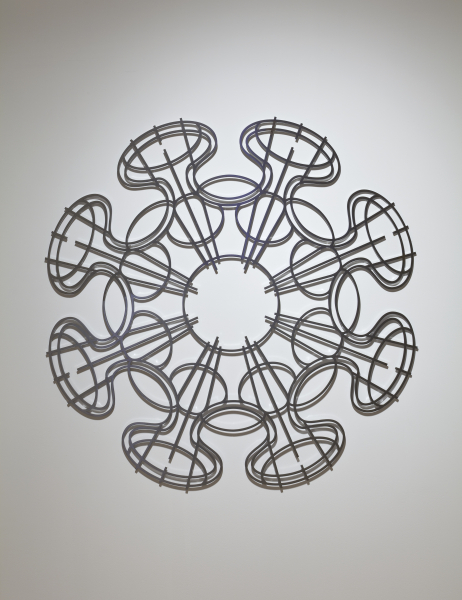Sculptures kakophoniques
- Judith SHWARZ
Why Sculptures kakophoniques?
When I started I had a lot of preparatory imagery but nothing seemed interesting except one small configuration and when I repeated and organized this ‘oval’ it seemed to have a sound, or could make a sound, something like castanets and so I referred to the image that started to develop as Klakker. But it’s not something you can quite hear, it’s more a sensation of possible sound.
So, in naming the exhibition…
Naming is always a big challenge for an artist like myself where there is no narrative content. If you’re really organized like Sol Lewit, you establish an index/numerical system early in your career. My titles are descriptive but with this show I wanted something that picked up on the idea of imaginary sound, but also the quirky feel of the imagery. And also I wanted something visceral; that works in both French and English.
Were you thinking of synethesia when you did this show?
Not really. I try to repress the intellectualization of work when I’m in the middle of the process. It’s hard enough to access the deeper (non verbal) creative self and I find that overt goals usually get in the way. I started with a lot of images from the last few years but nothing worked as expected. I really had to start at zero, at least it felt like that.
Are you saying the process took an odd turn?
Well yes, thankfully. Because it’s impossible to do a show when you don’t believe in your imagery; if you feel you have already been there and done that. I didn’t have the technical skill base either, such as the co-ordination to do a Bezier curve in Illustrator.
How did you manage to get something going?
I followed my own advice! I’m always urging students to persist. Put in the hours. Most of us are not talented, we are simply obsessive. I just tried everything and went on wild goose chases and diversions and kept coming back to that oval that seemed to have a rhythm that would produce a sound if you could only hear it. So I loaded up on a whole bunch of sessions and started about eight to ten different pieces. Some days I would walk away and think ‘well that was a waste of time’ but of course it wasn’t, it was the creative process.
You’ve been working this way for awhile, using the wall, using the circle as a template. Don’t’ you find it confining?
Yes and no. The dynamic of the circle doesn’t seem to get old for me. The center versus the outer edge, how to balance these conditions; negotiate all the cultural weight the circle contains, from corporate logos to celtic designs to Christian iconography, to produce something that feels fresh and contemporary. It’s an engaging challenge for me. And I love this process of working with industry. The production quality is so high and the process so specific to fabrication materials and methods that the outcome is a really specific cultural object, so obviously man made. Of course the interplay is that I’m looking for a sensation within the image that connects us back to rhythm we might find in nature, patterns of interaction and a kind of energy or life-force that radiates from that pattern. Work that is still and yet constantly moving.
Professor Judith Schwarz, currently the Chair of the Visual Arts Department at York University has exhibited extensively for the past twenty-five years. Her work has been featured in numerous exhibitions including the Power Plant Toronto, the Canadian Embassy, Tokyo, Freedman Gallery, Pennsylvania; The Edmonton Art Gallery, Edmonton; the Charles S. Scott Gallery, Vancouver; the Leonard & Bina Ellen Art Gallery, Montreal. She has been an artist in residence at Artspace, Australia and part of the Visiting Artist Program at Open Studio, Toronto.
Over the past two decades Schwarz has made metal, wall-mounted sculptures scaled to the body and installed with reference to the architecture. The sculptural wall- works combine intricate patterning and illusionary perspective with familiar geometric forms. Her practice also encompasesses large-scale public commissions that stress integration between art and the environment. Projects include large scale water features in Vancouver and Toronto along with projects for Options for Homes (Distillery District) Waterpark Place (Harbourfront) and the TTC (St Clair) Toronto.
An active volunteer for the arts Professor Schwarz has been an elected board member of various artist run or public institutions such as the Sculpture Garden, the Art Gallery of Ontario, Mercer Union, Open Studio and C Magazine. Currently she is a board member of the Koffler Gallery.




















